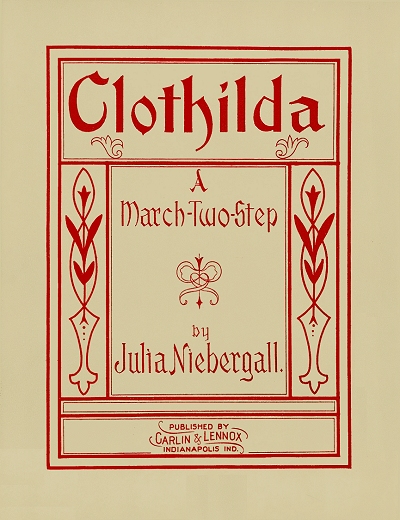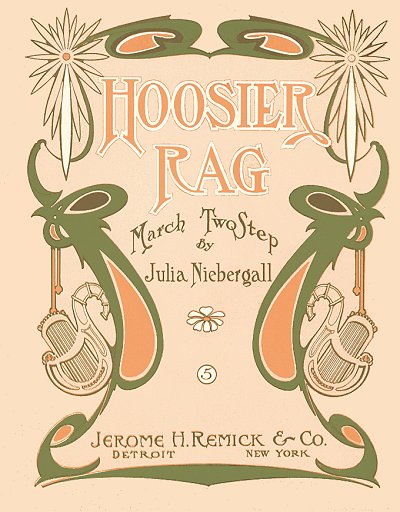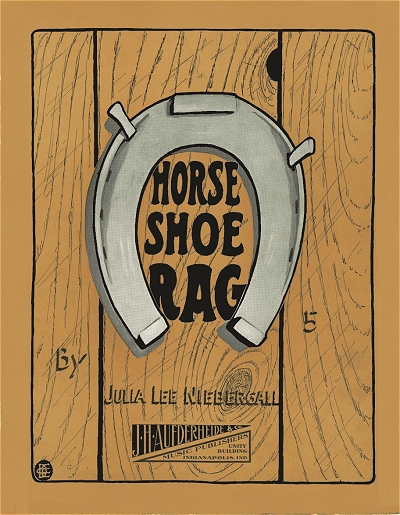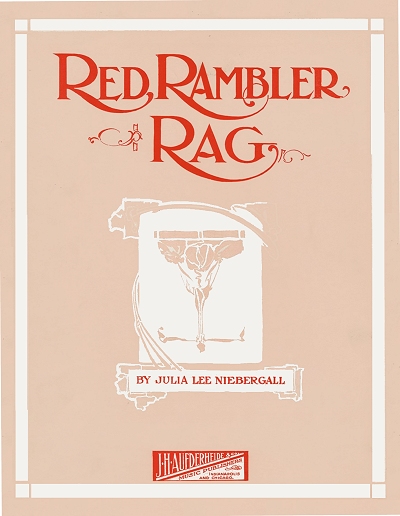|
Julia Lee Niebergall Ray (Feburary 15, 1886 to October 19, 1968) | |
 Compositions Compositions | |
|
1909
When Twilight is Falling (Song)1911
Horseshoe Rag1912
Red Rambler Rag | |
Julia Lee Niebergall was born in Indiana to George Niebergall, a print shop lithographer, and Minnie Krueger, who was likely already pregnant when the couple married on August 26, 1885. Julia was the oldest of two girls and a boy, including her brother Herbert J. (4/4/1888) and sister Mayme E. (10/1891). The product of a musical family, her father played the double bass with the Fred Turner Orchestra, and occasionally even with the Indianapolis Philharmonic. Herbert was a percussionist, and Mayme also took to the piano. In fact, Mayme appears to have been a student of her sister at one point. For the 1900 census the family was shown in Indianapolis with George as a lithographer and all of the children still in school.
Julia was the oldest of two girls and a boy, including her brother Herbert J. (4/4/1888) and sister Mayme E. (10/1891). The product of a musical family, her father played the double bass with the Fred Turner Orchestra, and occasionally even with the Indianapolis Philharmonic. Herbert was a percussionist, and Mayme also took to the piano. In fact, Mayme appears to have been a student of her sister at one point. For the 1900 census the family was shown in Indianapolis with George as a lithographer and all of the children still in school.
 Julia was the oldest of two girls and a boy, including her brother Herbert J. (4/4/1888) and sister Mayme E. (10/1891). The product of a musical family, her father played the double bass with the Fred Turner Orchestra, and occasionally even with the Indianapolis Philharmonic. Herbert was a percussionist, and Mayme also took to the piano. In fact, Mayme appears to have been a student of her sister at one point. For the 1900 census the family was shown in Indianapolis with George as a lithographer and all of the children still in school.
Julia was the oldest of two girls and a boy, including her brother Herbert J. (4/4/1888) and sister Mayme E. (10/1891). The product of a musical family, her father played the double bass with the Fred Turner Orchestra, and occasionally even with the Indianapolis Philharmonic. Herbert was a percussionist, and Mayme also took to the piano. In fact, Mayme appears to have been a student of her sister at one point. For the 1900 census the family was shown in Indianapolis with George as a lithographer and all of the children still in school.Having reportedly first started playing piano at age 12, she quickly learned her skill while involved with the Athenæum Turners club (turners being a German term for tumblers or gymnasts), part of the education program at the Athenæum/Das Deutsche Haus in Indianapolis. When she was around 16-years-old Julia was approached by Emil Ruth, director of the Normal [teachers] College in the east wing of the building, to become the accompanist for the school. She would continue to play for them for more than five decades. She also played for many years for the Indiana Athletic Club, the Hoosier Athletic Club and Manual High School for more than two decades from the late 1910s into the 1930s. During this time she managed to become very adept at improvisation, creating music on the spot appropriate for different styles or dance or gymnastics and exercise. Many students, according to her own recollection in later years, had issues with pronouncing her last name, so her nickname became the easier-to-manage "Jugee."
She also played for many years for the Indiana Athletic Club, the Hoosier Athletic Club and Manual High School for more than two decades from the late 1910s into the 1930s. During this time she managed to become very adept at improvisation, creating music on the spot appropriate for different styles or dance or gymnastics and exercise. Many students, according to her own recollection in later years, had issues with pronouncing her last name, so her nickname became the easier-to-manage "Jugee."
 She also played for many years for the Indiana Athletic Club, the Hoosier Athletic Club and Manual High School for more than two decades from the late 1910s into the 1930s. During this time she managed to become very adept at improvisation, creating music on the spot appropriate for different styles or dance or gymnastics and exercise. Many students, according to her own recollection in later years, had issues with pronouncing her last name, so her nickname became the easier-to-manage "Jugee."
She also played for many years for the Indiana Athletic Club, the Hoosier Athletic Club and Manual High School for more than two decades from the late 1910s into the 1930s. During this time she managed to become very adept at improvisation, creating music on the spot appropriate for different styles or dance or gymnastics and exercise. Many students, according to her own recollection in later years, had issues with pronouncing her last name, so her nickname became the easier-to-manage "Jugee."By her late teens Julia had become a friend of composer May Aufderheide, whose father would eventually publish two of Julia's works. To that end, she was part of that elite cadre of Indianapolis composers, women in particular, who capably represented their city with their unique music. For a time, however, she worked as a clerk in her father's place of employment, William B. Burford's lithography shop.
Julia was a truly independent woman who allegedly married young shortly after finishing school, but soon found out that marriage was not for her and divorced young as well, keeping her maiden name. Evidence of this marriage has been difficult to come by, and she shows as single, not divorced, in the 1910 census, so this was possibly confused with a marriage she entered into briefly several years later.
Julia's first piece, Clothilda, was published by Carlin & Lennox in Indianapolis in 1905. Labeled as a march, there are many implied syncopations throughout the A section and the Trio in the form of a sixteenth at the end of the first half of the measure followed by a sixteenth rest, which essentially has the same musical effect as a tied sixteenth from beat one into beat two. There are a few cakewalk rhythms present as well, making this more of a piano rag.
which essentially has the same musical effect as a tied sixteenth from beat one into beat two. There are a few cakewalk rhythms present as well, making this more of a piano rag.
 which essentially has the same musical effect as a tied sixteenth from beat one into beat two. There are a few cakewalk rhythms present as well, making this more of a piano rag.
which essentially has the same musical effect as a tied sixteenth from beat one into beat two. There are a few cakewalk rhythms present as well, making this more of a piano rag.Following Clothilda, Julia had a measure of success with her Hoosier Rag, which was eventually published by Jerome Remick in Detroit. It was followed by an interesting song issued in 1908, Bryan Cocktail, one of many musical tributes to the man destined to be remembered more for the famed Scopes trials than his time not serving as the President of the United States, William Jennings Bryan. The follow up to that was a gentle reverie-style piece, When Twilight is Falling.
Beyond that, Julia wrote only two more piano rags, both published by J.H. Aufderheide. She also acted as an arranger for the Aufderheide firm for a period of time. In spite of this activity, Julia was not officially enumerated as a composer or musician by trade, and in the 1910 census was listed as still living with her parents but with no profession. As an assertion of her fiery independence, it was widely known, according to research done by performer Max Morath, that Ms. Niebergall was one of the first women in Indianapolis to own and drive her own vehicle (although the make and model remain unknown).
One typical sighting of Julia utilizing her comic wiles is relayed in a late February 1911 edition of the Indianapolis Star, in which she attended the Maennerchor Costume Ball (their equivalent of Mardi Gras) dressed as Mary Quite Contrary, and later as Little Miss Muffet. That same week she had presented a musical monologue at a Daughters of the Revolution gathering. In fact, several other articles indicate that she was working at many Indianapolis events as a musical monologist (a pianist who gives comic or dramatic sketches punctuated with playing), often on the local B.F. Keith Vaudeville Theater, which also doubled as a cinema. Julia also played at her sister Mayme's wedding to Dr. Paul E. Bruick in Fort Wayne, Indiana, performing the famous Barcarolle from Offenbach's Tales of Hoffman, clearly demonstrating that she had some range as a classical pianist as well.
That same week she had presented a musical monologue at a Daughters of the Revolution gathering. In fact, several other articles indicate that she was working at many Indianapolis events as a musical monologist (a pianist who gives comic or dramatic sketches punctuated with playing), often on the local B.F. Keith Vaudeville Theater, which also doubled as a cinema. Julia also played at her sister Mayme's wedding to Dr. Paul E. Bruick in Fort Wayne, Indiana, performing the famous Barcarolle from Offenbach's Tales of Hoffman, clearly demonstrating that she had some range as a classical pianist as well.
 That same week she had presented a musical monologue at a Daughters of the Revolution gathering. In fact, several other articles indicate that she was working at many Indianapolis events as a musical monologist (a pianist who gives comic or dramatic sketches punctuated with playing), often on the local B.F. Keith Vaudeville Theater, which also doubled as a cinema. Julia also played at her sister Mayme's wedding to Dr. Paul E. Bruick in Fort Wayne, Indiana, performing the famous Barcarolle from Offenbach's Tales of Hoffman, clearly demonstrating that she had some range as a classical pianist as well.
That same week she had presented a musical monologue at a Daughters of the Revolution gathering. In fact, several other articles indicate that she was working at many Indianapolis events as a musical monologist (a pianist who gives comic or dramatic sketches punctuated with playing), often on the local B.F. Keith Vaudeville Theater, which also doubled as a cinema. Julia also played at her sister Mayme's wedding to Dr. Paul E. Bruick in Fort Wayne, Indiana, performing the famous Barcarolle from Offenbach's Tales of Hoffman, clearly demonstrating that she had some range as a classical pianist as well.During the 1910s and 1920s Ms. Niebergall taught music on and off at Manual High School, and in her capacity as a professional pianist focusing mostly on playing for movies at the Colonial Theatre right up until recorded soundtracks took over, as well as for other stage presentations and social events. Many of these events were reported on in the Indianapolis Star throughout the 1910s. At one April of 1915 church event, in which her picture was published with the article, Julia was said to have played Desecration Rag, likely the Felix Arndt piece by that name. She occasionally played for ballet and gym classes when her services were requested. Julia was also an active entertainer in Indianapolis during the war effort, raising funds and morale for soldiers, particularly those overseas without any parents for whom a local organization wrote letters of support. She was once again active after the war, featured in a minstrel show in 1919 among other events. Despite this continual activity, Julia still listed no occupation for the 1920 census. Newspaper references for her seem to evaporate in the 1920s as well, except for a few scant mentions of her as an accompanist, probably at Athenæum Turners events.
Julia tried marriage (allegedly for a second time), starting on February 26, 1921, to Mr. George Ray in Hendricks County, but was subsequently divorced from him by the mid-1920s, resuming her maiden name. In later years she taught some piano and music theory and played for gymnastic classes at the Athenæum, where she was a member of the Women's Auxiliary.
She was listed in the 1930 census as still living with her father, her mother having been deceased by that time, and working as a teacher in a music school, the first listing of her in a census in the music profession. Her father George, who never took a vacation during his tenure as a lithographer with the William B. Burford Printing Company, had been forced into retirement by a stroke in 1925, and was in her care until his death in 1932.
 |
The 1934 Indianapolis city directory listed Julia as a musician. As of the 1940 enumeration she was living alone, claiming a birth year of 1897, two years younger than she had claimed in 1930 (11 years off her actual age), and listed as a music teacher. In the 1942 and 1943 Indianapolis directories she was listed as a pianist and music teacher respectively. After that, Julia relocated south to Bloomington, Indiana, where she was listed as a musician or music teacher in city directories through 1958. A 1955 Bloomington city directory listing had her working as an employee for Indiana University, offering the intriguing possibility that she was teaching music at a college level, or perhaps still as an accompanist.
Having been able to support herself and maintain her own home as a professional musician and teacher, Julia Lee Niebergall was a great example of what a determined person, not just a woman, could accomplish with passion and hard work. That passion continued almost until her death in Indianapolis in October, 1968, at age 82, around three years after her retirement. Over the next decade, thanks in part to the efforts of performer and historian Max Morath, Julia and her Indianapolis colleagues became better known to the musical world, and her legacy remains with the ragtime community into the 21st century.
Most of the information on Julia's life was dervied from newspaper mentions and government records. Additional notes were provided by Max Morath from his 1970s research, and an article in the Alumin Bulletin of Normal College of A.G.U. of Indiana University from February, 1966, on the occasion of their centennial.